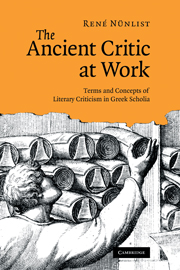Book contents
- Frontmatter
- Contents
- Acknowledgments
- Introduction
- PART I
- 1 Plot
- 2 Time
- 3 Narrative and speech
- 4 Focalisation
- 5 Effects on the reader
- 6 Gaps and omissions
- 7 Poetic licence
- 8 Authentication
- 9 Style
- 10 Allusions, hints, hidden meanings
- 11 Characters
- 12 Mythography
- PART II
- Epilogue
- Glossary of Greek terms
- Editions of scholia
- Other abbreviations
- Bibliography
- Thematic index
- Index locorum
3 - Narrative and speech
Published online by Cambridge University Press: 29 August 2009
- Frontmatter
- Contents
- Acknowledgments
- Introduction
- PART I
- 1 Plot
- 2 Time
- 3 Narrative and speech
- 4 Focalisation
- 5 Effects on the reader
- 6 Gaps and omissions
- 7 Poetic licence
- 8 Authentication
- 9 Style
- 10 Allusions, hints, hidden meanings
- 11 Characters
- 12 Mythography
- PART II
- Epilogue
- Glossary of Greek terms
- Editions of scholia
- Other abbreviations
- Bibliography
- Thematic index
- Index locorum
Summary
This chapter takes as its starting-point ancient classifications of literary art as a whole. The relevant terms, in particular those for ‘narrative’ and ‘drama’, then came to be used in various contexts and for different purposes, including the designation of sections of a text as ‘narrative’ or ‘dramatic’ (i.e. speech). These applications are examined in the second part of the chapter. It is rounded off by briefly looking at other classifications that are developed in the extant scholia.
THE THREE PRINCIPAL FORMS OF LITERARY ART: NARRATIVE, DRAMATIC AND MIXED
A b-scholion on the Homeric Catalogue of Ships explicitly refers to a well-known ancient categorisation of literary art:
τρεῖς δέ ϕησιν ὁ Πλάτων λόγων ἰδέας, δραματικήν, ἔνθα ὁ ποιητὴς συνεχῶς εὐδοκιμεῖ τοῖς ἢθεσι τῶν ὑποκειμένων προσώπων, ἀμίμητον, ὡς τὴν Φωκυλίδου, μικτήν, ὡς τὴν Ἡσιόδου.
(schol. b Il. 2.494–877 ex., p. 289.5–8 Erbse)Plato says that there are three forms of literary art, the dramatic, where the poet constantly distinguishes himself by means of the characters represented, the amimetic, such as Phocylides', the mixed, such as Hesiod's.
The reference is obviously to Plato's famous categorisation in the Republic (393d–394d) where he distinguishes between (a) διήγησις ἁπλῆ (‘simple/pure narrative’), that is, texts which consist of narrator-text only and contain no speeches, (b) μίμησις (‘mimesis, imitation’), that is, texts which consist of speeches only and contain no narrator-text, and (c) a mixture of both, for which Plato has no specific term and simply writes δι᾿ ἀμϕοτέρων (‘by means of both’).
Information
- Type
- Chapter
- Information
- The Ancient Critic at WorkTerms and Concepts of Literary Criticism in Greek Scholia, pp. 94 - 115Publisher: Cambridge University PressPrint publication year: 2009
